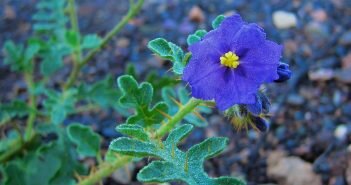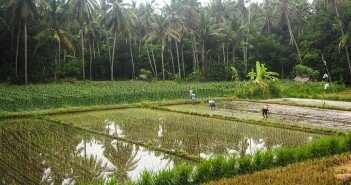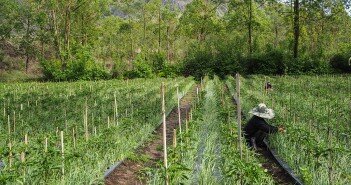The Hazelwood Farm case study is part of a $125 millions dollars project from the National Landcare Programme investment to deliver a boots for sustainable farms across New South Wales in Australia. This project is called Farm with a future and will deliver grants to farmers on certain project, which would increase the sustainability of their farm. They also provide a great network, information and ground work days where farmers get together to share knowledge.
The Hazelwood Farm case study highlights past and current challenges, how they manage them now and will in the future in a sustainable way.
Farm Overview
The 38 hectares Hazelwood Farm is owned and operated by Sarah and Wayne Merriman and their children. It is located 12km North East of Braidwood in a Cold Temperate climate, on the edge of a State Forest. The farm is subject to East Coast Lows (heavy rain events), with an average annual rainfall between 900 and 1200mm.
The aspect is predominantly North West facing at 670-710m above sea level. With soils of silty loam, 4.5 hectares are dedicated to income producing fruit, nut and vegetables with occasional cattle grazing on 22.5 hectares and rest left to natural bush, windbreaks, dams and gullies.
The main income for Hazelwood Farm comes from the market garden, fruit orchard and berry production.
Background
When the Merriman family took over Hazelwood Farm in 2004, it was a large overgrazed paddock, extremely open to the elements, with a handful of trees in the gully (see right) and an acidic soil pH, in some places as low as 4.3.
There was poor water retention and little grass cover as the previous owner had operated under a set grazing regime (keeping stock in each paddock throughout the year) for livestock, and it was the middle of a drought.
Changes that have been made
The first large scale improvement made on Hazelwood Farm was to add lime to the paddocks raising the pH to 4.9 and increase fencing to better manage grazing. A grant was obtained to fence off the Spring Gully, allowing amazing recovery and regrowth which has significantly improved the gully’s water retention and quality. A large dam was built and fenced to provide reticulated water (via troughs) for cattle as well as water for food production.
“Our focus has been to increase the biodiversity of the farm by simply planting a large mixture of natives and exotics and fencing these areas off” says Sarah Merriman.
The next major project was development of the hazelnut orchard and windbreaks were also planted to protect the orchard, prevent soil moisture loss and encourage micro biotic growth– an additional benefit has been the increase in bird and wildlife. A mixture of native and exotic plants have also been placed around the house site providing further habitat and shelter for birds and wildlife.
The productive Market Garden and Fruit Orchard have been protected by high fences to exclude wildlife. Food production on Hazelwood Farm has been relatively successful through a focus on soil improvement including mushroom compost, on-farm compost and worm wee, sifted ash from the fire, seaweed and a homemade “organic” fertiliser. “However, we will never be able to make enough compost or worm wee to improve our open pasture” says Wayne Merriman.
Irrigation is through an inline drip irrigation system directly targeting the plants roots system so that there is very little nutrient and evaporation loss.
“Most of these practices have come about through trial and error. It has been and still is very labour intensive.”
Plans for the Future of Hazelwood Farm
“Our main goal is not only to improve our patch of land and food production but to do it in a way that is both environmentally and also economically sustainable.”
Soil
The pasture soils on Hazelwood Farm have been subject to years of set stocking, leaving the soils compact and pasture growth stunted. There is a need to work on soil improvement through aeration, water retention and increased ground cover. The initial focus will be on continuing to divide the farm into more paddocks in order to better manage livestock grazing.
The focus for the Nut and Cider Orchard areas will be to move away from a monoculture crop by planting understory and complementary plants to encourage biodiversity both in and above the soil.
Water Retention and Quality
Whilst a lot of regeneration has occurred in the Spring Gully, additional woodlot and diverse native plantings will fill gaps and small (10cm) leaky weirs will help slow the water further and ensure it is stored in the ground.
Water retention in the open pasture needs improving as during rain events the water simply flows over the surface. It is envisaged that Keyline ploughing with a Yeomans Plow and/or the creation of small swales on contour, along with better grazing management, are the best options to start to address this issue and also help improve the pasture soils.
Whilst some planting has occurred around the dam, in order to maintain water quality it is envisaged that additional shrub and tree planting will occur along with aquatic plants for the dam edges.
Biodiversity Enhancement Approaches
The focus for the open pastured areas is to create and fence off large windbreaks across two major ridges, which will also divide the paddocks for better grazing. In addition one of these will provide a wildlife corridor between the native bush on the neighbouring property and the plants in the gully. As fertility begins at the top of a hill/ridge, it is useful to have plantings there that will increase soil carbon. Also, without any plantings on the ridge the topsoil is at high risk of washing away with a major rain event such as the South East Lows.
Ideally the owners would like to fence off 8 hectares of original bush in order to exclude cattle entirely and stop the destruction of new understory species.
Biodiversity enhancement will continue in the Market Garden and Fruit/Nut Orchards with the creation of additional windbreaks and understorey plantings.
Acknowledgements: SCPA-South East Producers, South East Local Land Services, Hazelwood Farm.
This case study was originally published on the SCPA, Farm with a future website.






1 Comment
Pingback: Hazelwood Farm: Case Study of a sustainable far...